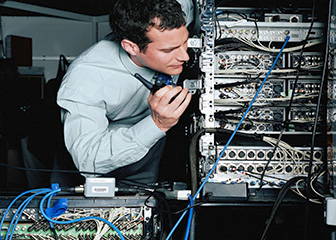Summary

| Quick Facts: Telecommunications Equipment Installers and Repairers Except Line Installers | |
|---|---|
|
$54,710 per year
$26.30 per hour |
|
| Postsecondary non-degree award | |
| None | |
| Moderate-term on-the-job training | |
| 194,900 | |
| 15% (About as fast as average) | |
| 28,400 | |
What Telecommunications Equipment Installers and Repairers Except Line Installers Do
Telecommunications equipment installers and repairers, also known as telecom technicians, set up and maintain devices or equipment that carry communications signals, connect to telephone lines, or access the Internet.
Work Environment
Telecommunications equipment installers and repairers generally work in climate-controlled central offices or electronic service centers. Some workers travel frequently to installation and repair sites, such as homes and offices. Most installers and repairers work full time, and overtime is common.
How to Become a Telecommunications Equipment Installer or Repairer Except Line Installer
Postsecondary education in electronics and computer technology is important for telecommunications equipment installers and repairers. For more complex work, a 4-year degree may be the best preparation. Industry certification is required for some positions.
Pay
The median annual wage of telecommunications equipment installers and repairers was $54,710 in May 2010.
Job Outlook
Employment of telecommunications equipment installers and repairers is expected to grow 15 percent from 2010 to 2020, about as fast as the average for all occupations. Those with postsecondary education and strong customer-service and computer skills will have the best job opportunities.
Similar Occupations
Compare the job duties, education, job growth, and pay of telecommunications equipment installers and repairers except line installers with similar occupations.
O*NET
O*NET provides comprehensive information on key characteristics of workers and occupations.
Contacts for More Information
Learn more about telecommunications equipment installers and repairers except line installers by contacting these additional resources.







